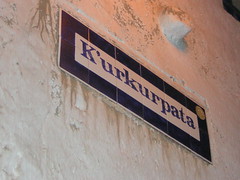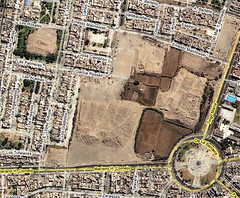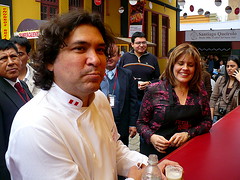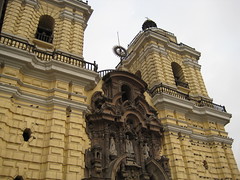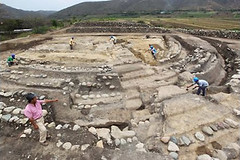Lima city districts at war over boundaries
One thing you can say about living in Peru is that there’s never dull moment. Things happen here that just don’t happen elsewhere… like Lima city districts fighting for control of territory and tax payers.
Believe it or not, this involves clashes between each district’s auxiliary police and residents trying to gain footholds in disputed territories with their security posts, and mayors accusing each other of threatening behaviour. We can only hope things don’t escalate to having standing armies invading neighbouring districts in bloody imperial conquest.
The worst conflict by a long shot is that between large and wealthy San Isidro and more run down Magdalena del Mar.
San Isidro is home to the highest property prices, the nation’s banking sector and many high-income residents who pay a pretty penny to their municipality who are able to keep well-kept clean and pot-hole free streets, and a visible auxiliary police (called Serenazgo) presence.
Magdalena on the other hand is mostly made up of working class residents. Where San Isidro houses the country’s biggest banks and institutions, Magdalena is home to a huge produce market. With less income through taxes, there are noticeably less green spaces, more pot-holed roads and areas that are decisively sketchy.
However, between the two districts sits an area of a few dozen blocks that was never properly attributed to either. Here live a few hundred middle-class tax-paying families who would be a huge asset to poorer smaller Magdalena and another slice of thick chocolate cake for fattened San Isidro. Both sides want their prize.
Agreement
So, surely there are court cases, perhaps some polite but strong words between officials? Nothing as extreme as rioting? Don’t be silly, where would be the fun in talking it out?
Although the disagreement has been going on for years, with both mayors accusing the other of stalling talks, garbage trucks having strict limits on where they could go (but that still left some blocks with double service and some without any), and territorial limits for auxiliary police and their watch posts.
One particular agreement was struck that meant San Isidro’s auxiliary police could not build permanent watch post structures on disputed blocks in an attempt to further their claim on the areas. Temporary structures could be erected to serve San Isidro’s security personnel and the disputed area, but building with concrete on what Magdalena considered theirs could not take place. This agreement was reached in 2004, and also involved agreements on zoneification.
Disagreement
What was called a Gentleman’s Agreement seems to have fallen apart in recent months.
Mayor Antonio Meier of San Isidro had repeatedly accused Mayor Francis Allison of Magdalena of violating zoning agreements in the disputed area by approving certain constructions and granting licenses. Each time Allison denied the agreement had been violated and stated that no zoning codes had be violated.
A meeting was arranged at the end of September 2008 by city authorities to sort out the conflict. But it didn’t seem to go very well. Not very well at all.
Afterwards, Mayor Meier stated to the press that Mayor Allison threatened to “send three hundred heavily armed auxiliary police to massacre those of San Isidro” and fill buses full of volunteers from Magdalena to take part in protests in San Isidro. Meier also complained that Allison said he’d – rough translation – “kick the sh*t” out of one of San Isidro’s representatives at the meeting, if he ever found him walking the streets of Magdalena.
Mayor Allison furiously denies saying anything like this. But either way, one of these men representing their districts is deeply insane.
Violence
The long standing conflict came to blows several times this month as tempers flared. It seemed San Isidro’s serenazgo was trying to permanently establish their security posts in the disputed area and had started placing concrete foundations. A direct violation of agreements and a challenge to Magdalena.
The worst response this act provoked was on 11th March, after several smaller clashes between Magdalena residents and San Isidro’s serenazgo in the previous days. As workers attempted to lay foundations at the start of the day, residents of Magdalena showed up to confront San Isidro’s security forces. This confrontation became violent, as residents attempted to tear down the construction materials. The mini rampage lasted ten minutes until national police arrived to restored order. Construction was prevented, all materials were destroyed.
Arguments
San Isidro and its mayor maintain that those mostly middle class residents who live of the disputed area would prefer to live in San Isidro, hinting that San Isidro has a certain prestige and that Magdalena is some kind of hole that working class Limeños live in. Mayor Meier accuses Mayor Allison of busing in residents from rougher areas of Magdalena to take part in protests and violent acts, that the residents in the disputed area completely support him.
This can’t be entirely true, as interviews conducted by Peru’s news media seemed to indicate split loyalties. One reason might be the lower tax rates in Magdalena del Mar.
Allison denies busing in anyone, also denying the accusation from San Isidro that he is trying to prevent a referendum. Decades old now, how this conflict will end no-one knows.
Other conflicts
The fight between Magdalena and San Isidro is one of FOURTY in Lima. Its not surprising considering how fast the city grew, with towns growing and being over run by the sprawling metropolis in just a few decades and in a disordered unplanned manner.
Every now and then higher authorities try to resolve these conflicts, but the desire for additional tax payers is so strong that talks often result in nothing. Disputed zones are either left without municipal services or are provided with double services while both districts try to collect taxes.
Current conflict zones include:
Callao-Lima Metropolitana, Chorrillos-Surco, Chorrillos-Barranco, Chorrillos-Villa El Salvador, San Juan de Miraflores-Chorrillos, Ancón-Puente Piedra, Magdalena-San Miguel, Magdalena-Pueblo Libre, Punta Hermosa-Punta Negra, San Bartolo-Santa María del Mar, Pucusana-Santa María del Mar, Surquillo-San Borja, Surco-Barranco and Ate-Surco.
Some districts were not even officially founded before expanding exponentially, let alone had their boundries declared. These areas were just settled and towns sprung up during the early years of Peruvian independence. These include: Bellavista, Ate-Vitarte, Carabayllo, Chosica, Pueblo Libre, Pachacámac and Santiago de Surco.
Although I hope this insanity will eventually end, Lima, and Peru, is at least a far more interesting place because of it.
Tags: border, francis allison, lima, magdalena del mar, protest, san isidro




